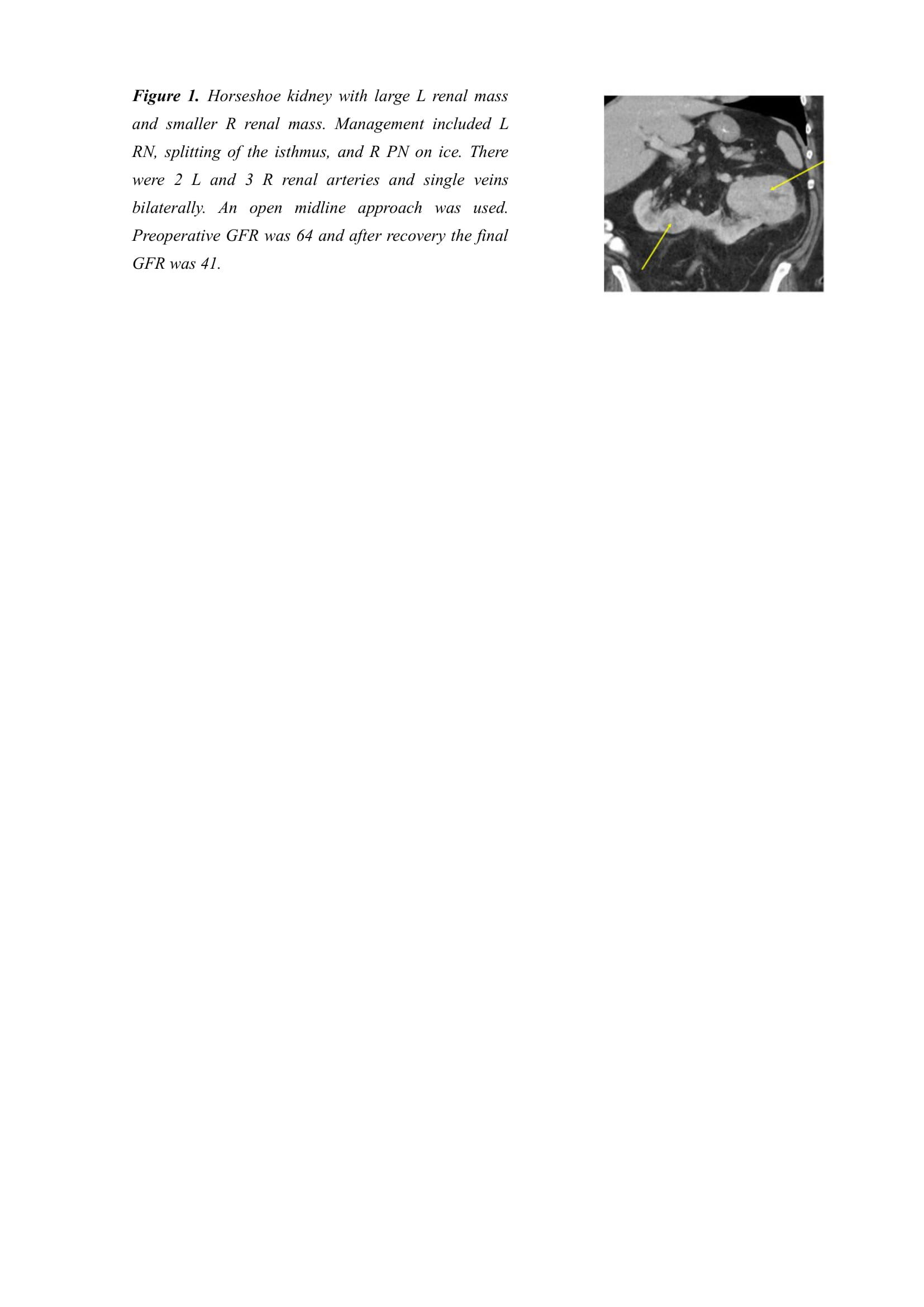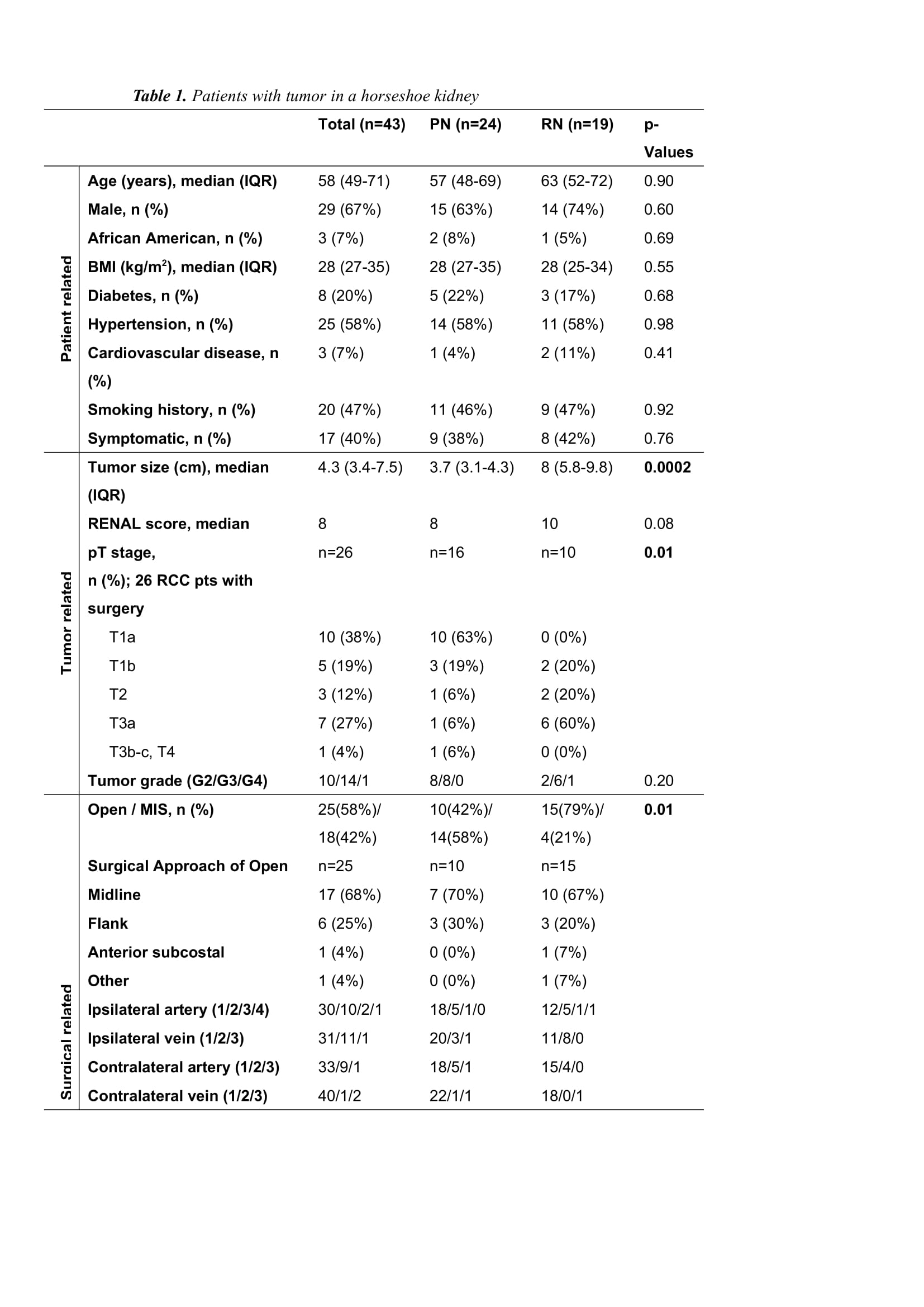Back
Poster, Podium & Video Sessions
Podium
PD56: Kidney Cancer: Localized: Surgical Therapy IV
PD56-06: Surgery for Renal Masses in Horseshoe Kidneys
Monday, May 16, 2022
10:20 AM – 10:30 AM
Location: Room 255
Yosuke Yasuda*, JJ Zhang, Nityam Rathi, Gustavo Roversi, Ao Zhang, Diego Palacios, Jihad Kaouk, Georges-Pascal Haber, Venkatesh Krishnamurthi, Robert Abouassaly, Christopher Weight, Steven Campbell, Cleveland, OH
- YY
Yosuke Yasuda, MD
Tokyo Medical and Dental University
Podium Presenter(s)
Introduction: Surgery for horseshoe kidneys with tumors presents challenges due to aberrant vascular anatomy and risk of AKI/CKD. We evaluate outcomes in this challenging patient population.
Methods: Patients who underwent management of a renal mass in a horseshoe kidney at our center (1999-2021) were reviewed. Baseline characteristics, surgical approach, complications, and pathologic, functional and survival outcomes were analyzed.
Results: 43 procedures were performed (42 patients) with horseshoe kidneys consisting of 24 (56%) partial nephrectomy (PN) and 19 (44%) radical nephrectomy (RN) with division of the isthmus. One patient had both RN and PN (Fig.1). 26/43 cases (60%) were diagnosed incidentally (Table 1). Median tumor size and RENAL score were 4.3 cm and 8, respectively. On final pathology, only 27 (63%) tumors were RCC, and 10 (23%) were benign. Complex vascular anatomy was common (36% of patients). 25/43 (58%) of cases were performed open, the remainder were MIS. Of open cases, 68% were performed through a midline incision and 32% via alternate incisions. Median OR time was 233 min with median EBL 325cc; 12% were transfused. 90-day Clavien III-IV complication rate was 12%, and there were no mortalities. For PN, median warm ischemia time (IT) was 26 min and cold IT 31 min. New baseline/long-term eGFR were 67/66 ml/min/1.73m2 overall and 83/78 ml/min/1.73m2 after PN versus 48/57 ml/min/1.73m2 after RN (p=0.01/0.03). Dialysis was required in 7% overall (0% after PN). Tumor size, RENAL, and tumor stage were increased in the RN group. Median follow-up was 36 months. 5-yr RFS rates were 76 % overall and 83 % for PN versus 66 % for RN. Overall, 6 patients died of cancer.
Conclusions: Management of renal masses in horseshoe kidneys is challenging and requires versatility with multiple surgical approaches to provide safe and effective outcomes. Preservation of renal function was accomplished in the majority of patients, with a functional advantage for PN. RCC was less common than usual, and benign tumors more prevalent, suggesting strong consideration for preoperative renal mass biopsy.
Source of Funding: none


Methods: Patients who underwent management of a renal mass in a horseshoe kidney at our center (1999-2021) were reviewed. Baseline characteristics, surgical approach, complications, and pathologic, functional and survival outcomes were analyzed.
Results: 43 procedures were performed (42 patients) with horseshoe kidneys consisting of 24 (56%) partial nephrectomy (PN) and 19 (44%) radical nephrectomy (RN) with division of the isthmus. One patient had both RN and PN (Fig.1). 26/43 cases (60%) were diagnosed incidentally (Table 1). Median tumor size and RENAL score were 4.3 cm and 8, respectively. On final pathology, only 27 (63%) tumors were RCC, and 10 (23%) were benign. Complex vascular anatomy was common (36% of patients). 25/43 (58%) of cases were performed open, the remainder were MIS. Of open cases, 68% were performed through a midline incision and 32% via alternate incisions. Median OR time was 233 min with median EBL 325cc; 12% were transfused. 90-day Clavien III-IV complication rate was 12%, and there were no mortalities. For PN, median warm ischemia time (IT) was 26 min and cold IT 31 min. New baseline/long-term eGFR were 67/66 ml/min/1.73m2 overall and 83/78 ml/min/1.73m2 after PN versus 48/57 ml/min/1.73m2 after RN (p=0.01/0.03). Dialysis was required in 7% overall (0% after PN). Tumor size, RENAL, and tumor stage were increased in the RN group. Median follow-up was 36 months. 5-yr RFS rates were 76 % overall and 83 % for PN versus 66 % for RN. Overall, 6 patients died of cancer.
Conclusions: Management of renal masses in horseshoe kidneys is challenging and requires versatility with multiple surgical approaches to provide safe and effective outcomes. Preservation of renal function was accomplished in the majority of patients, with a functional advantage for PN. RCC was less common than usual, and benign tumors more prevalent, suggesting strong consideration for preoperative renal mass biopsy.
Source of Funding: none



.jpg)
.jpg)